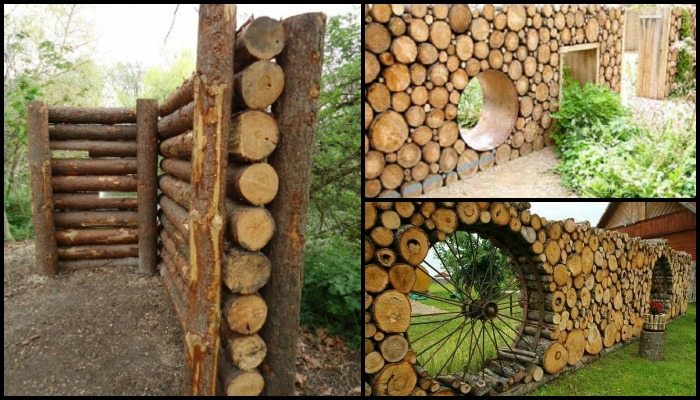
A cordwood fence lets you upcycle unused lumber into a solid barrier around your home. This lumber fence adds privacy around your home while it boost your outdoor aesthetic.
It’s an inexpensive project for those living near or out in the woods. It’s also a great option for those who want a truly unique design. You can create images/portraits with it (like these) and it allows for curvy layouts!
You can call it cordwood, log-end, or stack wood fence. And just as it can be called a few different names, there are also various ways to build one. It all depends on your location, your design preference, budget, and the type of wood available to you.

If you are going for the really strong and permanent kind, then you can build one with the use of mortar, just like the walls of these cordwood homes.
On the other hand, if you are considering the possibility of having to take it out in the future, dry stacking would be the better option for you. As the name implies this method does not use mortar for reinforcement. You basically just place log ends on top of each other like you would with puzzle pieces. This is also the best option for those living in moist or rainy areas as mortar/concrete tends to trap moisture and speed up the decaying process of wood.

Now regardless of where you are and what exact building method you use, it is important to always use rot-resistant wood for this project! Cedar, Osage Orange, Redwood, and Black Locust are some of the good choices. If you want, you can even use Bois d’arc which is one of the hardest hardwoods out there!
Have a look at some examples from our album below for cordwood fence design ideas and be inspired to build your own! :)
Is this the perfect fence for your yard?
Contents
Building a Cordwood Fence
- Materials:
- Rot-resistant wood (e.g., Cedar, Osage Orange, Redwood, Black Locust)
- Mortar mix (if not dry stacking)
- Sand
- Lime (optional, for a more flexible mortar mix)
- Water
- Landscaping fabric or barrier (optional, for weed control)
- Gravel or crushed stone (for base)
- Tools:
- Measuring tape
- Saw (for cutting wood to length)
- Trowel (for applying mortar)
- Level
- Rubber mallet (if dry stacking)
- Wheelbarrow (for mixing mortar)
- Shovel
Steps to Build a Cordwood Fence:
- Plan and Design:
- Determine the layout of your fence. Consider the height, length, and design pattern of the cordwood.
- Check local building codes and regulations to ensure compliance.
- Prepare the Site:
- Clear the area where the fence will be built, removing any vegetation, rocks, or debris.
- Level the ground as much as possible to provide a stable base for your fence.
- Lay the Foundation:
- Dig a trench about 6 inches deep and 12 inches wide along the marked line of your fence.
- Fill the trench with gravel or crushed stone to create a drainage layer and compact it firmly.
- (Optional) Pour a concrete foundation for a more permanent and sturdy base.
- Install a Weed Barrier (Optional):
- Lay landscaping fabric or a barrier over the gravel layer to prevent weed growth through your fence.
- Mix the Mortar (If Using):
- In a wheelbarrow, mix the mortar, sand, lime (if used), and water according to the manufacturer’s instructions. Aim for a consistency that holds its shape without being overly wet.
- Begin Layering the Cordwood:
- Apply a layer of mortar along the base where the first row of cordwood will sit (skip this step if dry stacking).
- Place the first row of cordwood pieces tightly against each other, using the level to ensure they are straight.
- Continue adding layers of mortar and cordwood, staggering the joints for added stability.
- Maintain Consistency:
- Use the trowel to remove any excess mortar that squeezes out between the logs.
- Keep checking the level of the fence with each row to ensure it remains straight and consistent in height.
- Cure the Mortar:
- Allow the mortar to cure according to the manufacturer’s instructions, which may take several days.
- Avoid applying force or pressure to the fence during this time.
- Finishing Touches:
- Once the mortar has fully cured, you can apply a sealant to the cordwood and mortar for extra protection against the elements.
- (Optional) Landscaping or planting can be done around the base of the fence to integrate it with your garden.
Historical Background and Cultural Significance
The use of cordwood in construction, including cordwood fences, holds a rich history and cultural significance that spans across various regions and epochs. This building method, known for its sustainability and aesthetic appeal, has been a part of human architecture for centuries, providing insight into the ingenuity and resourcefulness of past and present builders.
Introduction to Cordwood Construction
Cordwood construction, also known as “log end” building, involves using short lengths of wood, typically the byproduct of forest management or sustainable wood harvesting, to create structures. This technique has been utilized for building everything from homes and outbuildings to the focus of our interest, cordwood fences. The appeal of cordwood construction lies in its simplicity, the use of natural materials, and its thermal efficiency, making it a favored method in eco-conscious communities.
Historical Roots
The history of cordwood construction is difficult to trace precisely, as it likely originated independently in various parts of the world, wherever wood was a plentiful resource. Evidence suggests that ancient civilizations in Northern Europe and North America used cordwood techniques for constructing dwellings and fortifications. In recent history, settlers in Canada and the United States adopted cordwood construction for homes and fences, attracted by the abundance of wood and the method’s suitability for harsh climates.
Symbol of Sustainability
In modern times, cordwood construction, particularly cordwood fences, symbolizes a commitment to environmental stewardship and sustainable living. This building method aligns with contemporary values of reducing waste, utilizing local materials, and minimizing the environmental impact of construction activities.
Artistic Expression
Cordwood fences offer a canvas for artistic expression, allowing builders to create patterns and designs by varying the type of wood, the end cut shapes, and the mortar color. This aspect of cordwood construction showcases the cultural tendency to blend functionality with beauty, making each fence a unique piece of art that reflects the builder’s creativity and the natural beauty of the surrounding environment.
Community and Tradition
Building a cordwood fence is often a community effort, bringing together neighbors, friends, and family in a shared project. This sense of community involvement refers to traditional barn raisings and communal constructions, emphasizing the importance of teamwork and collective achievement. Furthermore, the technique is passed down through generations, preserving traditional skills and fostering a connection to the land and local resources.
The cordwood fences’ historical background and cultural significance are deeply interwoven with sustainability themes, artistic expression, and community. As a representation of eco-friendly construction methods, cordwood building practices, including creating cordwood fences, continue to inspire those seeking to live in harmony with nature while upholding the traditions and innovations of the past.
Click on any image to start the lightbox display. Use your Esc key to close the lightbox. ![]()


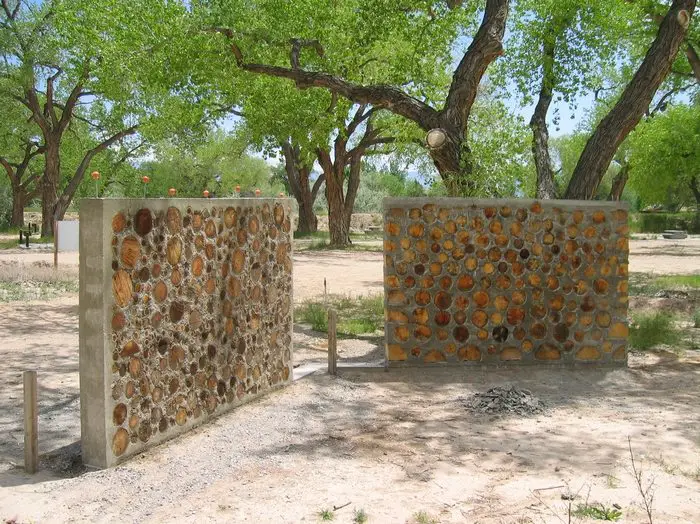
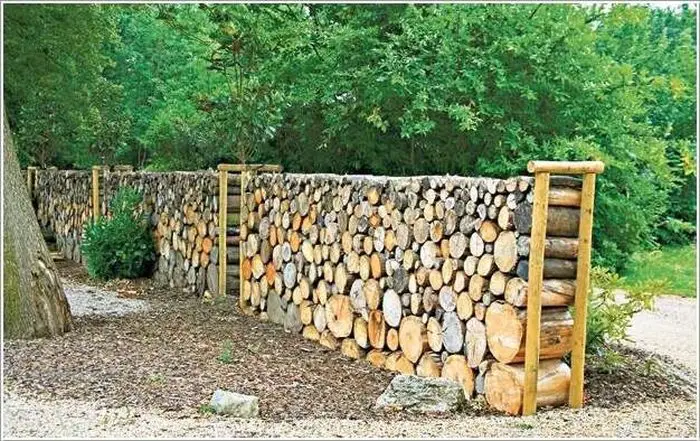
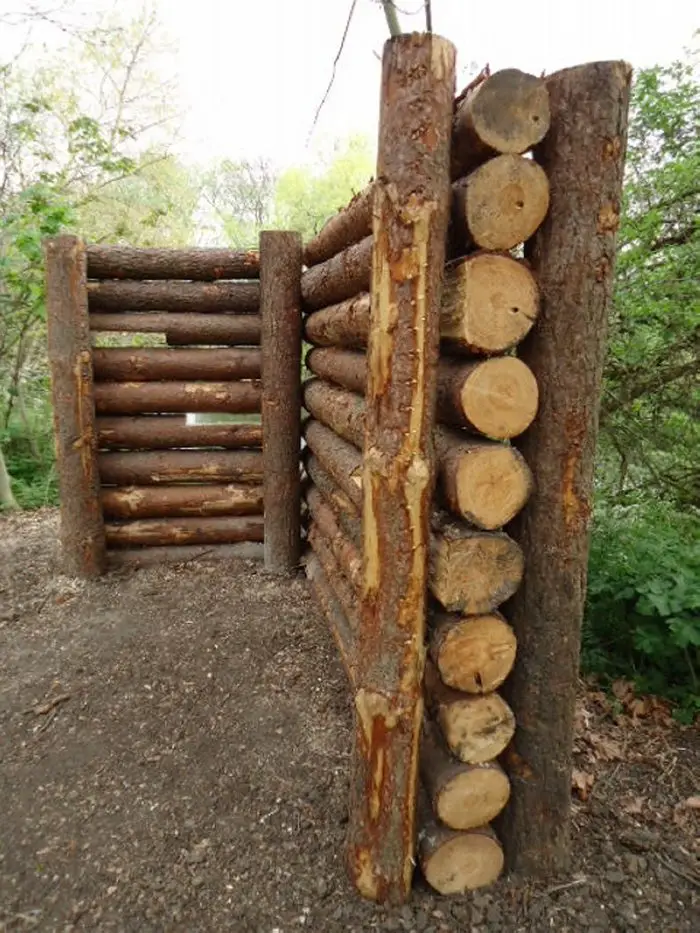


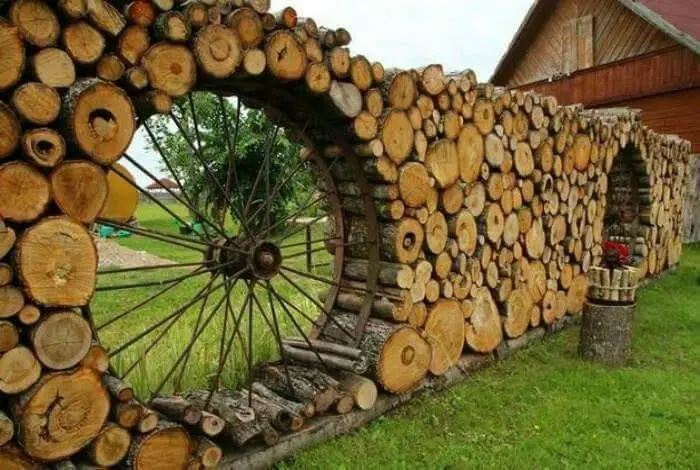

Maintenance and Durability
A cordwood fence combines the rustic charm of natural wood with the structural integrity of mortar (in some cases) to create a functional and decorative barrier. While inherently durable, the longevity of a cordwood fence can be significantly extended through regular maintenance and care.
Protecting the Wood
Selection of Wood
The choice of rot-resistant wood such as Cedar, Osage Orange, Redwood, or Black Locust is the first step toward ensuring the durability of your cordwood fence. These woods offer natural resistance to decay and pests.
Wood Treatment
A wood preservative can protect against moisture, UV damage, and insects. It’s important to choose an environmentally friendly sealant that is appropriate for the type of wood used in your cordwood fence.
Stain and Paint Options
Beyond preservatives, applying a stain or paint designed for outdoor use can add an extra layer of protection against the elements while enhancing the natural beauty of the wood. Choose products that offer UV protection and can breathe, to prevent trapping moisture within the wood.
Regular Cleaning
Mildew and mold can degrade wood over time. Clean the wood surfaces gently with a solution of water, mild detergent, or a mixture of vinegar and water, to remove any buildup. This maintains the aesthetic appeal and prevents the wood from deteriorating.
Proper Ventilation
Ensuring good air circulation around each piece of wood within the fence can significantly reduce the risk of moisture-related decay. When designing and building your cordwood fence, consider spacing strategies that allow air to flow freely around the wood.
Mortar Maintenance
Inspection and Repair
Regularly inspect the mortar for signs of wear, such as cracks or erosion. Early detection and repair of these issues can prevent moisture infiltration and structural damage.
Repointing
Repointing, the process of renewing the external part of mortar joints, is crucial for maintaining the structural integrity of fences that utilize mortar. This task should be performed by someone familiar with cordwood construction to ensure the correct mortar mix and application method are used.
Compatible Materials
When repairing or repointing the mortar, it’s crucial to use materials that are compatible with the original mortar to avoid potential chemical reactions that can lead to further damage. Understanding the composition of the existing mortar can guide the selection of repair materials.
Sealant Application
Applying a sealant to the mortar can help repel water and reduce the penetration of moisture, which is especially beneficial in climates prone to heavy rain or freeze-thaw cycles. Ensure the sealant is appropriate for use with mortar and does not compromise the breathability of the material.
Monitoring for Vegetation
Keep an eye out for any plants or vines growing on or near your cordwood fence. Roots and vegetation can widen cracks in the mortar over time, leading to structural issues. Regularly trim any vegetation to keep the fence clear and reduce the risk of damage.
Addressing Environmental Challenges
Moisture Control
Ensure proper drainage around the fence to prevent water from pooling at the base, which can lead to wood rot and compromise the fence’s foundation.
Sunlight and Weather Protection
Consider the orientation of your fence and the local climate. In extremely sunny areas, additional UV protective treatments may be necessary. Regular checks and prompt repairs after storms will help maintain the fence’s integrity in areas prone to harsh weather.
Adaptation to Climate
Tailor the care of your cordwood fence to your specific climate. For instance, in regions with heavy snowfall, it’s crucial to regularly clear snow buildup that can cause moisture to linger and potentially damage the wood.
Landscaping Considerations
Thoughtfully plan your landscaping to protect your cordwood fence. Planting shrubs or trees nearby can provide shade and wind protection, but ensure they are placed safely to prevent root damage to the foundation and reduce moisture retention from plant matter.
Wildlife Protection
Depending on your location, wildlife can threaten the integrity of your cordwood fence. Consider installing physical barriers or using natural deterrents to protect the fence from animal damage.
Cleaning and Aesthetics
Gentle Cleaning
Keep your cordwood fence looking its best by gently cleaning the wood and mortar with appropriate solutions to remove dirt, algae, or moss. Avoid harsh chemicals or high-pressure washers that can damage the wood and mortar.
Periodic Inspection
Conduct a thorough inspection of your cordwood fence at least once a year to identify any potential issues before they become major problems. Look for signs of decay, pest infestation, or structural weakness.
Natural Cleaners
For an eco-friendly approach to cleaning your cordwood fence, consider using vinegar or baking soda solutions. These natural cleaners can effectively remove grime without harming the wood or surrounding plant life.
Staining and Coloring
Periodically applying a stain can refresh the look of your cordwood fence and provide an additional layer of protection against the elements. Choose a stain that complements the natural color of the wood and is designed for outdoor use.
Decorative Enhancements
Enhance the aesthetic appeal of your cordwood fence by incorporating decorative elements such as climbing plants, solar-powered lights, or even custom carvings into the wood. These additions can turn your fence into a focal point of your garden or yard.
Regular Grooming
Remove any leaves, twigs, or debris accumulating on or around your cordwood fence. This keeps the fence tidy and prevents organic material from decomposing against the wood, which could lead to moisture damage and decay.
A cordwood fence is more than just a boundary; it’s a statement of aesthetic preference and environmental consciousness. With proper maintenance and care, your cordwood fence can endure for decades, becoming more beautiful with age.
Environmental Benefits and Sustainability
Cordwood construction, particularly in the context of cordwood fences, embodies sustainable building principles through the use of natural, often locally sourced materials, energy efficiency, and minimal waste production. This approach not only enhances the beauty of a property but also contributes positively to the environment.
Use of Natural and Recycled Materials
Cordwood fences utilize short logs that can be sourced from sustainable forests or from wood that might otherwise go to waste. This promotes the responsible use of timber resources, reducing the environmental impact associated with deforestation and the overharvesting of wood.
The cordwood construction method is ideal for recycling and reclaiming wood. Old, unused logs, fallen trees, and even scrap wood can find new life as part of a durable and attractive fence, minimizing waste in landfills.
Energy Efficiency and Insulation
The thermal mass provided by the wood and mortar composition of cordwood fences offers natural insulation. This can contribute to energy savings in adjacent buildings by moderating temperature variations, showcasing the method’s efficiency.
By utilizing local wood and minimizing the need for processed materials, cordwood fences can significantly reduce the carbon footprint associated with transporting and manufacturing conventional fencing materials.
Enhancing Biodiversity
Cordwood fences can support biodiversity by providing niches for small creatures and insects. The nooks and crannies within the fence can serve as habitats, contributing to a balanced ecosystem in your garden or yard.
Using local wood helps preserve the natural habitat by reducing the demand for exotic woods and promoting the growth of native forests, which are crucial for maintaining ecological balance.
Minimizing Environmental Impact
The construction process of a cordwood fence is relatively low-impact, requiring minimal machinery and reducing the disturbance to the surrounding land. This method aligns with the principles of permaculture and sustainable land use.
Cordwood fences are incredibly durable, lasting many years with proper maintenance. This longevity reduces the need for frequent replacements, lessening the continuous demand on natural resources and minimizing waste.
Cordwood fences embody the essence of sustainable construction, offering a harmonious blend of functionality, beauty, and environmental stewardship. By opting for cordwood construction, individuals can contribute to a healthier planet, promoting the use of renewable resources, enhancing local biodiversity, and reducing the ecological footprint of their building projects.
Conclusion
Building a cordwood fence offers a unique blend of aesthetic appeal, environmental sustainability, and practical functionality. This construction method not only utilizes natural and reclaimed materials, reducing waste and supporting eco-friendly practices, but also creates a durable, energy-efficient boundary that enhances the beauty of any property.





